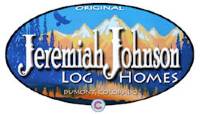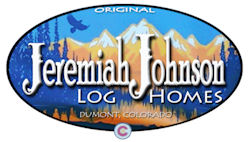Anchor Bolt: A steel bolt, which is embedded in the concrete foundation of a structure and used to anchor the sill plate.
Angle Brace: Any timber bracing a corner at an angle across that corner. Also called a knee brace.
Angle Iron: An L shaped length of steel frequently used to support masonry over a window or door opening.
Base Course: The first or bottom course of masonry blocks, or logs in a wall (sill logs).
Beam: A main horizontal member used to support vertical loads.
Bearing Wall: A wall supporting a vertical load.
Bird’s Mouth (Cut): A V shaped notch cut into the base of a rafter that allows the rafter to sit flat on the wall or the plate.
Blue Stain: A blue or grey discoloration in sapwood caused by mildew infection.
Buck: A vertical board fastened to the ends of log sections at the window or door openings to secure them in place and to which the window or doorjamb is fastened.
Butt Joint: A joint made by fastening two logs together without overlap. The two members are square cut and joined at the flat surface.
Cambium Layer: A formation of cellular tissue, which lies between the wood and the bark of a tree. When this is left intact and the bark is removed, it will dry to a shiny dark finish.
Cantilever: A structural member supported on one end but extending beyond its support on the other end.
Cat Face: An indentation on the surface of a tree, usually caused by injury at some earlier date.
Caulking: Material used to seal the joints between logs or between windows and walls, doors and walls, etc.
Checking: A surface crack in a log caused by drying.
Chinked Structure: A building designed to use chinking material between the lateral lengths of the log work.
Chinking: Either the material or the process by which gaps between logs are filled.
Collar Tie/Collar Beam: A horizontal timber, which ties two opposite pairs of rafters together near the middle to reduce sagging or spreading.
Cope: A notch in a log that is cut and rounded to fit over another log.
Corbel: A short horizontal timber supporting a girder.
Countersink: To cause the head of a bolt or spike to be below the surface of the wood into which it is embedded.
Course of Logs: One layer of logs around the house perimeter.
Cove: A shallow, round shaped groove cut into the underside of a log.
Crown Post: A central vertical post that connects the collar tie to the bent plate.
Dead Load: Weight that a structural member is supporting by the weight of the structure. Does not include snow, wind, furniture, people, cars etc.
Diagonal: Reaching from corner to opposite corner at an angle.
Dormer: A window or a smaller roofed area protruding from a sloping roof.
Dowel: Wooden peg used to hold two pieces of wood together.
Eave: The lower or bottom edge of a roof that projects beyond the face of the walls.
Eave Soffit: The underside of the eave.
Expansion Joint: A joint, which permits expansion without doing damage to the structure.
Fascia: The trim board that usually covers the exposed ends of rafters or overhang.
Flashing: Weatherproof stripping used to seal joints between masonry and wood framing or log work, and masonry and roofing.
Floor Joists: The heavy beams that support the flooring.
Framing: The network of lumber in a building that will be covered by finish material.
Gable: The triangular portion at the top of a wall enclosed by the roof at the ends of the house.
Gable End: The wall in a house that has a gable roof.
Gable Roof: A sloping roof that forms an ‘A’ shape.
Gambrel Roof: A roof with one slope steeper than the other.
Girder: A horizontal structural member that supports joists.
Girt: A major horizontal timber that connects posts.
Grain: Direction of cellular arrangement in wood.
Half-Lap: A type of joint in which two timbers are lapped or let into one another.
Header: Horizontal members between vertical posts which add support.
Heart Wood: The wood in a tree, which extends from the middle of the trunk outward towards the sapwood.
Hip: The sloping ridge of a roof formed by two intersecting roof slopes.
Hip-Rafter: The rafter that forms the hip of a roof.
I-Beam: A steel beam with a cross section that makes it resemble the letter I.
Jack Rafter: A short rafter that extends from the roof ridge to a valley rafter or from the wall plate to a hip rafter.
Joinery: Connecting timbers by means of woodworking joints.
Joint: Any place where two or more timbers meet.
Joists: Horizontal, parallel timbers used to support the floor, ceiling, or roof.
Joist Hanger: A metal support for the ends of joists.
Kerf: The groove left in a piece of wood by a saw cut.
King Post: A vertical support that transfers weight from the ridge beam to the end walls or the joists.
Knee Brace: A small timber that is framed diagonally between a post and beam.
Lag Screw: A heavy screw for wood with a bolt head.
Lateral Groove: A longitudinal groove cut into the underside of a log enabling that log to fit over the top of another log.
Load Bearing: Carrying the weight of a structure.
Loft: The second floor in a home where the roof forms both its ceiling and walls usually associated with houses possessing a cathedral ceiling.
Mortise: A square or rectangular slot cut into a log, timber, or board into which another member, usually called a tenon, will fit.
Mortise and Tenon Joint: A joint in which a projection (tenon) of one timber is inserted into a slot (mortise) of another timber.
Moisture Content: Percentage by weight of water in wood.
Newel: The bottom post to which a stair railing is attached. Also post supporting sections of railings.
Notch: A recess cut into a log to accept another log intersecting it at an angle.
• Blind Notch: A notch that does not extend completely through a log.
• Boxed Lapped Notch: A notch cut squarely into part of each timber
• Dovetail Notch: Log ends cut into a fan appearance resembling a dove’s spread tail.
• Half Dovetail Notch: Log end where one side only is sloped.
• Mitered Lapped Notch: Notch that has a 45-degree slope on the sides of the square notch.
• Round Notch: A notch in which the profile of the log exhibits the shape of a partial circle on the underside.
• Round Sheep’s Head Notch: Same as a Sheep’s Head Notch except that the outer cuts retain a round shape.
• Saddle Notch: Notch that is triangular in profile.
• Sheep’s Head Notch: A notch with sloped sides partially cut out of each log.
• Square Notch: Has the appearance of a round notch on the exterior but inside has a square interlocking lap.
Notching: The art of cutting a notch into logs.
Outrigger Beam: A log which sites atop a cantilevered logs on the eave walls and is parallel to and extends out beyond the plate logs. It is to this beam that the roof framing is attached.
Overhang: That part of the roof that extends beyond the outside wall.
Peg: A wooden dowel of oak, locust or other woods.
Piece-en-Piece: A style of building in which vertical support posts form the main structure of a home with short lengths of logs forming the wall panels in sections between the posts.
Pitch: The slope or angle of a roof. Also, the hardened sap of a coniferous tree.
Plate-Log: The log at the top of the wall that supports the roof.
Post and Beam: A style of building that uses vertical posts supporting horizontal members and beams.
Purlins: A roof support log reaching from end to end of the structure and placed in line between plate log and the ridgepole. Usually, it is used to support rafters.
Rafter: A structural member, usually dimensional lumber that supports a roof.
Rafter Truss: A triangle of two rafters and a horizontal brace. Several of these make up a roof sub-structure.
Ridge Beam: A horizontal timber at the peak of the roof to which rafters are attached. Also called a ridge board, ridge piece, or ridgepole.
Roof Pitch: Inches of rise per 12” of roof run.
Roof Truss: A network of structural members that form a rigid support for the roof.
Round of Logs: One layer of logs around the entire perimeter of the house.
Saddle: The lower cut in a notch and saddle joint. The log is cut on an angle on each side so that the surface almost comes to a point at the top of the log.
Sapwood: The outer layer of wood in a tree that is nearest to the bark.
Scarfed: A cut at a long angle in the direction of the timber.
Scribe: The process of cutting one log to match the contours of another for a tight log-to-log fit.
Scribe-Fit: A building featuring tight log-to-log joinery.
Screw Jack: A device that may be adjusted to allow for the settlement in log walls.
Settling: Loss of wall height by shrinkage and compression.
Shed Roof: A sloping roof of a single plane.
Sill Log: The base log that sits upon the foundation.
Sills: Horizontal members that form the base of window and door openings.
Soffit: the underside of the roof overhang.
Splice: A joint of two logs end to end.
Spline: A narrow wooden strip placed into grooves cut into two adjoining surfaces of a log wall.
Taper: The amount of change in the diameter of a log from the butt end to the top end.
Truss: Structural members assembled into a rigid frame.
Through-Bolting: Threaded rod of various length used as a tensioning device in log walls, post and beam joinery and some timber frames.
Glossary Courtesy of From Land to Lockup © ILBA Reprint Edition www.logassociation.org
Questions? Give Us a Call Today!
Or Use This Form to Email Us:
LEARN MORE ABOUT OUR CUSTOM LOG HOMES
Luxury accents & quality craftsmanship go into everything we make. With three generations (spanning 118 years) of custom and log home construction, our unsurpassed experience guarantees that your custom log home expectations will be met. At Jeremiah Johnson Custom Log Homes, we have a passion for what we do, take pride in every detail of our work and do our utmost to satisfy our customers.

